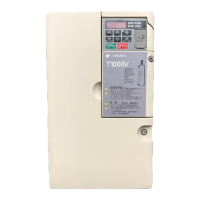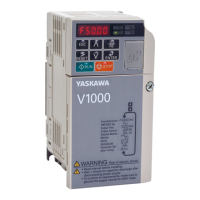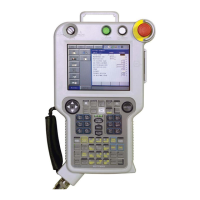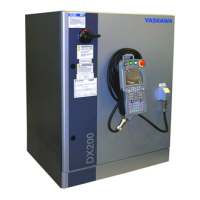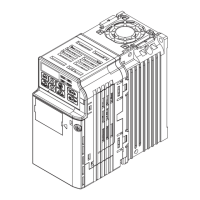6.4 Fault Detection
284 YASKAWA ELECTRIC SIEP C710616 30B YASKAWA AC Drive T1000A Technical Manual
Digital Operator Display Fault Name
oH
Heatsink Overheat
The temperature of the heatsink exceeded the overheat pre-alarm level set to L8-02. Default value for L8-02 is determined by
drive capacity (o2-04).
Cause Possible Solution
Surrounding temperature is too high.
• Check the temperature surrounding the drive. Verify temperature is within drive specifications.
• Improve the air circulation within the enclosure panel.
• Install a fan or air conditioner to cool the surrounding area.
• Remove anything near the drive that might be producing excessive heat.
Load is too heavy.
• Measure the output current.
• Decrease the load.
• Lower the carrier frequency (C6-02).
Internal cooling fan is stopped.
• Replace the cooling fan. Refer to Cooling Fan Component Names on page 320.
• After replacing the drive, reset the cooling fan maintenance parameter (o4-03 = 0).
Digital Operator Display Fault Name
oH1
Overheat 1 (Heatsink Overheat)
The temperature of the heatsink exceeded the drive overheat level. The overheat level is determined by drive capacity (o2-04).
Cause Possible Solution
Surrounding temperature is too high.
• Check the temperature surrounding the drive.
• Improve the air circulation within the enclosure panel.
• Install a fan or air conditioner to cool the surrounding area.
• Remove anything near the drive that might be producing excessive heat.
Load is too heavy.
• Measure the output current.
• Lower the carrier frequency (C6-02).
• Reduce the load.
Internal cooling fan is stopped.
• Replace the cooling fan. Refer to Cooling Fan Component Names on page 320.
• After replacing the drive, reset the cooling fan maintenance parameter (o4-03 = 0).
Digital Operator Display Fault Name
oH3
Motor Overheat Alarm (PTC Input)
• The motor overheat signal to analog input terminal A1, A2, or A3 exceeded the alarm detection level.
• Detection requires multi-function analog input H3-02, H3-06, or H3-10 be set to “E”.
Cause Possible Solution
Motor has overheated
• Check the size of the load, the accel/decel times, and the cycle times.
• Decrease the load.
• Increase the acceleration and deceleration times (C1-01 through C1-08).
• Adjust the preset V/f pattern (E1-04 through E1-10). This will mainly involve reducing E1-08 and E1-10.
• Be careful not to lower E1-08 and E1-10 too much, as this reduces load tolerance at low speeds.
• Check the motor rated current.
• Enter the motor rated current as indicated on the motor nameplate (E2-01).
• Ensure the motor cooling system is operating normally.
• Repair or replace the motor cooling system.
Digital Operator Display Fault Name
oH4
Motor Overheat Fault (PTC Input)
• The motor overheat signal to analog input terminal A1, A2, or A3 exceeded the fault detection level.
• Detection requires that multi-function analog input H3-02, H3-06, or H3-10 = “E”.
Cause Possible Solution
Motor has overheated.
• Check the size of the load, the accel/decel times, and the cycle times.
• Decrease the load.
• Increase the acceleration and deceleration times (C1-01 through C1-08).
Adjust the preset V/f pattern (E1-04 through E1-10). This will mainly involve reducing E1-08 and E1-10. Be careful not to lower
E1-08 and E1-10 too much because this reduces load tolerance at low speeds.
• Check the motor rated current.
• Enter the motor rated current as indicated on the motor nameplate (E2-01).
• Ensure the motor cooling system is operating normally.
• Repair or replace the motor cooling system.
Digital Operator Display Fault Name
oL1
Motor Overload
The electronic motor overload protection tripped.
Cause Possible Solution
Load is too heavy. Reduce the load.
Cycle times are too short during acceleration and
deceleration.
Increase the acceleration and deceleration times (C1-01 through C1-08).
A general purpose motor is driven below the rated speed
with too high load.
• Reduce the load.
• Increase the speed.
• If the motor is supposed to operate at low speeds, either increase the motor capacity or use a motor specifically designed to
operate in the desired speed range.
The output voltage is too high.
Adjust the user-set V/f patterns (E1-04 through E1-10). Parameters E1-08 and E1-10 may need to be reduced. Be careful not to
lower E1-08 and E1-10 too much because this reduces load tolerance at low speeds.
The wrong motor rated current is set to E2-01.
• Check the motor-rated current.
• Enter the value written on the motor nameplate to parameter E2-01.
The base frequency is set incorrectly.
• Check the rated frequency indicated on the motor nameplate.
• Enter the rated frequency to E1-06 (Base Frequency).
Multiple motors are running off the same drive. Disable the motor protection function (L1-01 = 0) and install a thermal relay to each motor.
The electrical thermal protection characteristics and
motor overload characteristics do not match.
• Check the motor characteristics.
• Correct the type of motor protection that has been selected (L1-01).
• Install an external thermal relay.

